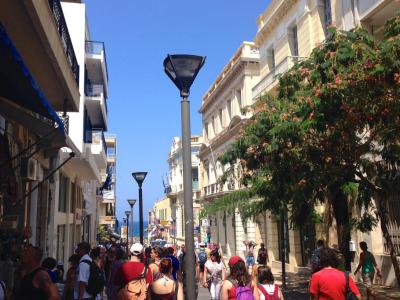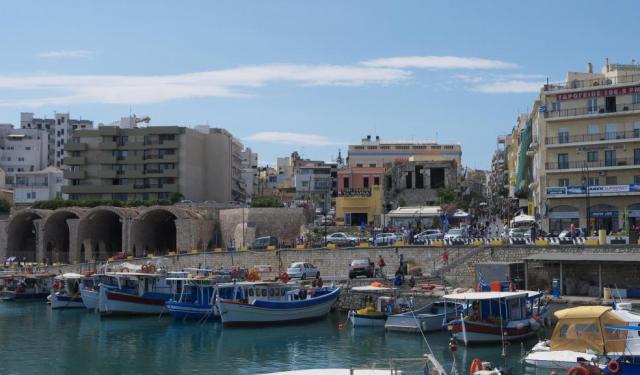
25th of August Street, Heraklion
Once called "Odos Planis" or "Illusion Street," 25th of August Street earned its ironic moniker due to the striking Neoclassical buildings that captivate visitors as they approach from the harbor. The street is now a paved pedestrian thoroughfare, lined with banks, travel bureaus, and tourist shops housed within these historic structures.
As you embark on your walk along 25th of August Street, the church of Saint Titus, the Loggia, and the Basilica of St Mark stand as architectural gems, each contributing to the street's allure. The street serves as a visual feast, bearing witness to the city's resilience and transformation after the catastrophic events of 1898.
The street's historical roots trace back to the Arab period in the 9th or 10th century, and it has consistently served as Heraklion's main artery, connecting the town center to the harbor. During the Venetian era, it was known as Ruga Maistra (Main Street), and in Ottoman times, it took on the name Vezir Tsarsi (Vizier's Market) after the Vezir Mosque.
The modern nomenclature of 25th of August Street bears the weight of a tragic event. On the 25th of August 1898, during the feast of St Titus, a frenzied Muslim mob committed a heinous act, resulting in the loss of many lives, including 17 British soldiers and the British Consul Lysimachos Kalokairinos. This violent episode prompted the Great Powers to intervene, leading to the protection of the island and, eventually, the Union of Crete with Greece in 1913.
As you embark on your walk along 25th of August Street, the church of Saint Titus, the Loggia, and the Basilica of St Mark stand as architectural gems, each contributing to the street's allure. The street serves as a visual feast, bearing witness to the city's resilience and transformation after the catastrophic events of 1898.
The street's historical roots trace back to the Arab period in the 9th or 10th century, and it has consistently served as Heraklion's main artery, connecting the town center to the harbor. During the Venetian era, it was known as Ruga Maistra (Main Street), and in Ottoman times, it took on the name Vezir Tsarsi (Vizier's Market) after the Vezir Mosque.
The modern nomenclature of 25th of August Street bears the weight of a tragic event. On the 25th of August 1898, during the feast of St Titus, a frenzied Muslim mob committed a heinous act, resulting in the loss of many lives, including 17 British soldiers and the British Consul Lysimachos Kalokairinos. This violent episode prompted the Great Powers to intervene, leading to the protection of the island and, eventually, the Union of Crete with Greece in 1913.
Want to visit this sight? Check out these Self-Guided Walking Tours in Heraklion. Alternatively, you can download the mobile app "GPSmyCity: Walks in 1K+ Cities" from Apple App Store or Google Play Store. The app turns your mobile device to a personal tour guide and it works offline, so no data plan is needed when traveling abroad.
25th of August Street on Map
Sight Name: 25th of August Street
Sight Location: Heraklion, Greece (See walking tours in Heraklion)
Sight Type: Attraction/Landmark
Guide(s) Containing This Sight:
Sight Location: Heraklion, Greece (See walking tours in Heraklion)
Sight Type: Attraction/Landmark
Guide(s) Containing This Sight:
Walking Tours in Heraklion, Greece
Create Your Own Walk in Heraklion
Creating your own self-guided walk in Heraklion is easy and fun. Choose the city attractions that you want to see and a walk route map will be created just for you. You can even set your hotel as the start point of the walk.
Heraklion Introduction Walking Tour
Heraklion is the vibrant capital of Crete and its primary port. The city traces its roots back to the Minoan era (from 2700 BC to 1450 BC). Under Minoan rule, the area flourished as a vital hub with the nearby palace of Knossos acting as its center of power and trade (in gold, ceramics, and saffron).
Following the Minoans' decline, Crete endured stagnation until the Roman occupation. The... view more
Tour Duration: 2 Hour(s)
Travel Distance: 2.3 Km or 1.4 Miles
Following the Minoans' decline, Crete endured stagnation until the Roman occupation. The... view more
Tour Duration: 2 Hour(s)
Travel Distance: 2.3 Km or 1.4 Miles

